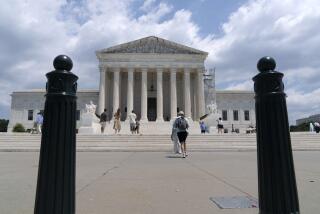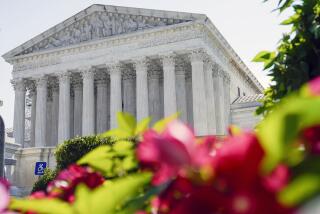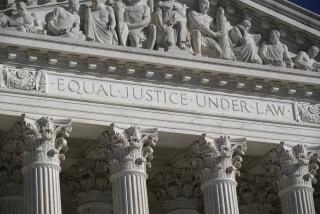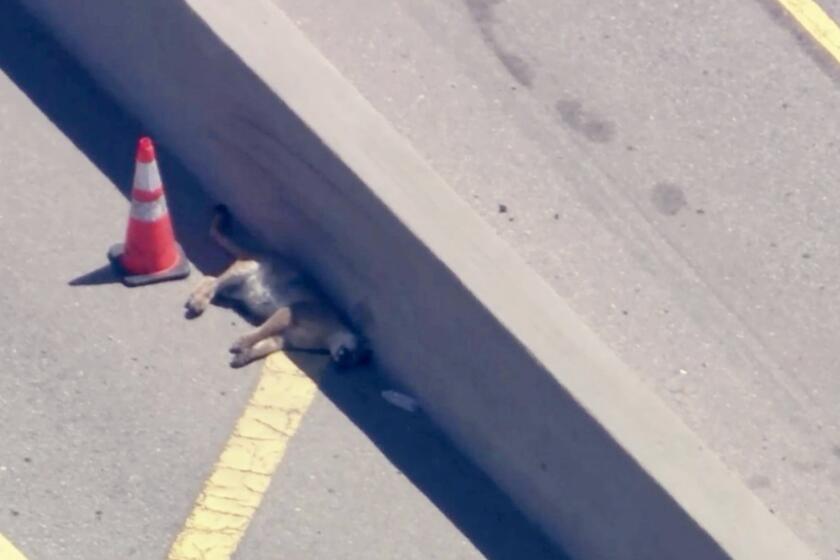Judge’s order that Times alter article sparks 1st Amendment fight
A federal judge’s decision ordering the Los Angeles Times to remove information it had published about a criminal case has sparked a battle over free speech that legal scholars said weighed in favor of the media.
U.S. District Judge John F. Walter issued the order after The Times published information on its website about a plea agreement between prosecutors and a former Glendale police detective accused of working with the Mexican Mafia.
The Times complied with the order but appealed it. Walter, appointed by former President George W. Bush, has scheduled an 8:30 a.m. hearing Tuesday to consider The Times’ challenge.
The newspaper also sought review Sunday night in the U.S. 9th Circuit Court of Appeals.
A three-judge 9th Circuit emergency-motions panel asked federal prosecutors and the detective’s lawyer to respond to the appeal by 5 p.m. Monday and gave The Times an opportunity to make further written arguments by 9 a.m. Tuesday.
The 9th Circuit judges reviewing the order are Barry G. Silverman, Susan P. Graber and A. Wallace Tashima. They were all appointed by President Clinton and are considered moderates.
On behalf of 59 media organizations, the Reporters Committee for Freedom of the Press filed a petition before the 9th Circuit late Monday proposing to file a friend-of-the-court brief in favor of The Times.
Those supporting The Times include the New York Times, the Washington Post, the Associated Press, the major network news broadcasters and other prominent media throughout the nation.
Constitutional scholars who have followed the case said Monday it was rare for a judge to issue the kind of order that Walter handed down. They also said the news media cannot lawfully be ordered to excise information they have lawfully obtained and published except in exceptional circumstances.
UC Berkeley Law School Dean Erwin Chemerinsky called the order “clearly unconstitutional.”
“If the media lawfully obtain it, they can truthfully report it,” Chemerinsky said. “There is a very strong presumption against a court telling the press what it can’t publish.”
UCLA law professor Eugene Volokh, also an expert in 1st Amendment law, agreed.
“While the U.S. Supreme Court hasn’t decided this very question, it has said that once something is in the public record, even if placed there accidentally, generally speaking people are allowed to write about it.”
Both scholars cited a 1989 U.S. Supreme Court ruling involving a Florida weekly that had accidentally published the name of a rape victim. Florida law barred publication of the names of rape victims, and the woman sued the paper and won damages.
The high court overturned the jury verdict and award, ruling it was unconstitutional to punish a newspaper for truthfully publishing information that the government released.
But both scholars agreed the law was not absolute and exceptions might be made for national security or to protect a person’s life.
If the plea agreement had been sealed to protect the defendant, former Det. John Saro Balian, “the judge would need to have a basis for believing that the order was necessary to achieve the compelling interest of protecting someone’s life and that there was no other way to achieve it,” Chemerinsky said.
Any evidence of danger would be examined by a reviewing court, Volokh said. Such evidence could include past threats or examples in which people in the defendant’s situation in the past had been killed, he said.
After Balian entered his guilty plea Thursday, the judge ordered the transcript of the hearing sealed.
Even though The Times removed the information from its website to comply with the order, details of the plea agreement can still be found online at other sites, a fact likely to favor the media, the professors said.
“This is the cat-is-out-of-the-bag principle, which in fact is how some courts have referred to it,” Volokh said.
Chemerinsky said the media can argue the order serves no practical purpose because the information is now in the public domain.
“The more it is disseminated, the less it can be said that forcing the L.A. Times to take it down will have any effect,” Chemerinsky said.
He cited a lawsuit filed against the Progressive magazine by the federal government in 1979 to prevent publication of an article that purportedly revealed the secret of making a hydrogen bomb, information the publication obtained from publicly available sources.
A trial judge ruled for the government, but the government eventually dropped its challenge while the case was on appeal because the information it sought to shield could easily be found elsewhere.
The written arguments filed by The Times, the detective’s lawyer and the government were sealed under orders of the district court.
The Times asked the 9th Circuit to allow the briefs to be made public, with information about the plea agreement redacted until the dispute is decided.
Craig Missakian, who is representing Balian, said The Times published the contents of the plea agreement even though the paper knew it had been sealed and made public only by mistake.
He declined to comment on his legal strategy in defending the order before the district court and the 9th Circuit.
In her practice over 35 years, Kelli L. Sager, an attorney representing The Times, said trial judges have from time to time issued emergency orders to restrain the media, only to quickly lift them once the media were allowed to argue against them.
The Times was not present when the order was issued, she said.
Tracy Webb, a spokesperson for the federal prosecutors’ office that negotiated the plea agreement, was asked whether the U.S. attorney was supporting the order that required The Times to remove the information from its website.
“We have no comment other than we are not a part of the [temporary restraining order] and we did not have any part in the temporary unsealing of the plea agreement,” Webb responded in an email.
Twitter: @mauradolan
More to Read
Start your day right
Sign up for Essential California for news, features and recommendations from the L.A. Times and beyond in your inbox six days a week.
You may occasionally receive promotional content from the Los Angeles Times.







